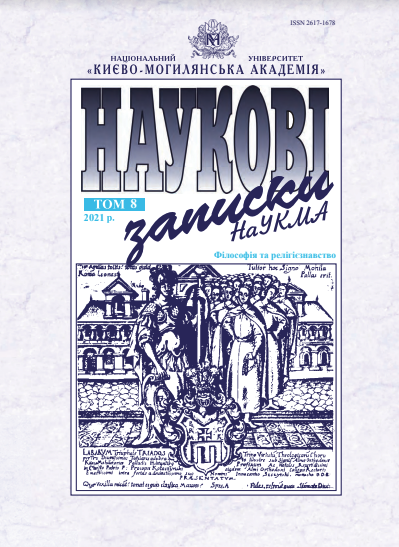До питання зображення жіночого насильства в Біблії: історії Яель та Юдити
DOI:
https://doi.org/10.18523/2617-1678.2021.8.80-87Ключові слова:
жінки у Старому Завіті, насильство і жінки, Яель, Юдита, патріархальне суспільство, релігійний дискурсАнотація
У статті проаналізовано біблійні історії двох жінок, Яелі та Юдити, і спосіб зображення насильства, вчиненого цими жінками над чоловіками. Ці тексти були написані у складних історичних обставинах. Розповідь про Яель із Книги Суддів 4–5 датовано XII–X ст. до н. е. – часом, коли 12 племен Ізраїлю конфліктували з іншими народами за територію Південного Леванту. Розповідь про Юдиту в однойменній книзі датовано ІІ ст. до н. е., коли юдеїв примусово еллінізували, а їхня територія стала частиною імперії Селевків. Зазначено, що обидві розповіді експліцитно вказують на колапс чоловічого правління та чоловічу немічність розв’язати проблему захисту народу від зовнішнього ворога. Звернено увагу, що історії Яелі та Юдити мають просвітницьку або повчальну мету, є тим, що ми сьогодні окреслюємо як «мислення за межами усталених рамок». Через неспроможність чоловіків дати раду із ситуацією згідно з патріархальними нормами поведінки й очікуваннями, сприйняття соціальних ролей і розуміння маскулінності й фемінності в критичних обставинах набирало інших сенсів. Історії Яелі та Юдити відображають саме цю кризу й успішний порятунок завдяки героїчним діям жінок.
Завантаження
Посилання
- Bledstein, A. J. (1993). Is Judges a Woman’s Satire of Men Who Play God? In A. Brenner (Ed.), A Feminist Companion to Judges (pp.34–54). Sheffield, England: Sheffield Academic Press.
- Boling, Robert G. (1992). Judges, Book of. In D. N. Freedman (Ed.), Anchor Bible Dictionary (Vol. 3, pp. 1107–1117). New Haven, CT: Yale University Press.
- Brenner, A. (1986). Female Social Behaviour: Two Descriptive Patterns within the ‘Birth of the Hero’ Paradigm. Vetus Testamentum, 36, 257–273.
- Brenner, A., & van Dijk Hemmes, F. (1996). On Gendering Texts: Female and Male Voices in the Hebrew Bible. Leiden: Brill.
- Claassens, J. (2013). Female Resistance In Spite of Injustice: Human Dignity and the Daughter of Jephthah. Old Testament Essays, 26 (3), 607–622.
- Craven, T. (2001). Judith 2. In C. Meyers, T. Craven, & R. S. Kraemer (Eds.), Women in Scripture: A Dictionary of Named and Unnamed Women in the Hebrew Bible, the Apocryphal/Deuterocanonical Books, and the New Testament (pp. 237–241). Grand Rapids, Mich.: Eerdmans.
- Fewell, D. N., & Gunn, D. M. (1990). Controlling Perspectives: Women, Men, and the Authority of Violence in Judg. 4–5. Journal of the American Academy of Religion, 58 (3), 405–406.
- Fischer, I. (1995). Women Who Wrestled with God. Biblical Stories of Israel’s Beginnings. Collegeville, Minn.: Fortress Press.
- Gentry, C. E., & Sjoberg, L. (2015). Beyond Mothers, Monsters, Whores. Thinking аbout Women’s Violence іn Global Politics. London: Zed Books Ltd, The Foundry.
- Gera, D. L. (2010). The Jewish Textual Traditions. In K. R. Brine, E. Ciletti, & H. Lähnemann (Eds.), The Sword of Judith: Judith Studies Across the Disciplines (pp. 23–40). Cambridge: Open
- Book Publishers.
- Hobyane, R. S. (2016). Body and Space in Judith: A Greimassian Perspective. Biblische Notizen, 168, 3–15.
- Mandolfo, C. (2019). Women, Violence, and the Bible: The Story of Jael and Sisera as a Case Study. Biblical Interpretation, 27, 340–353.
- Moore, C. A. (1995). Judith: A New Translation with Introduction and Commentary. New Haven, CT: Yale University Press.
- Reis, P. T. (2005). Uncovering Jael and Sisera: A New Reading. Scandinavian Journal of the Old Testament, 19 (1), 24–47.
- Sheaffer, А. (2014). Envisioning the Book of Judith: How Art Illuminates Minor Characters. Sheffield, England: Sheffield Academic Press.
- Trible, P. (1984). Texts of Terror: Literary-Feminist Readings of Biblical Narratives. Minneapolis, Minn: Fortress Press.
- van Dijk Hemmes, F. (1993). Mothers and a Mediator in the Song of Deborah. In A. Brenner (Ed.), A Feminist Companion to Judges (pp. 110–115). Sheffield: Sheffield Academic Press. van Henten, J. W. (1995). Judith as Alternative Leader: A Rereading of Judith 7–13. In A. Brenner (Ed.), A Feminist Companion to Esther, Judith and Susanna (pp. 224–252). Sheffield, England: Sheffield Academic Press.
- Webb, B. (2012). The Book of Judges. Grand Rapids, Mich.: Eerdmans.
##submission.downloads##
Опубліковано
Як цитувати
Номер
Розділ
Ліцензія
Авторське право (c) 2021 Halyna Teslyuk

Ця робота ліцензується відповідно до Creative Commons Attribution 4.0 International License.
Автори, які публікуються у цьому журналі, погоджуються з такими умовами:
а) Автори зберігають за собою авторські права на твір на умовах ліцензії Creative Commons Attribution License CC BY 4.0, котра дозволяє іншим особам вільно поширювати (копіювати і розповсюджувати матеріал у будь-якому вигляді чи форматі) та змінювати (міксувати, трансформувати, і брати матеріал за основу для будь-яких цілей, навіть комерційних) опублікований твір на умовах зазначення авторства.
б) Журнал дозволяє автору (авторам) зберігати авторські права без обмежень.
в) Автори мають право укладати самостійні додаткові угоди щодо поширення твору (наприклад, розміщувати роботу в електронному репозитарії), за умови збереження посилання на його першу публікацію. (Див. Політика Самоархівування)
г) Політика журналу дозволяє розміщення авторами в мережі Інтернет (наприклад, у репозитаріях) тексту статті, як до подання його до редакції, так і під час його редакційного опрацювання, оскільки це сприяє виникненню продуктивної наукової дискусії та позитивно позначається на оперативності та динаміці цитування опублікованої роботи (див. The Effect of Open Access).



